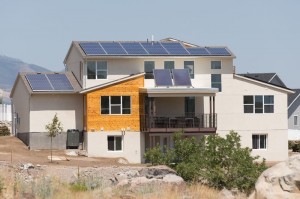For years we’ve been dreaming about living in sustainable homes that conserve energy and save us money. These types of homes have been featured in magazines and are generally owned by celebrities and millionaires who can afford to spend millions of dollars on a home. Unfortunately for the rest of us, these homes have remained steadfastly out of our price range.
A fairly new home technology company is seeking to change this assumption with its new, cutting edge “Zero Home” that costs a mere $400,000. This is not quite cheap enough for all budgets, but it is well within the price range of middle class families, considering that the home generates as much energy as it produces, eliminating energy bills and has the same price tag as other homes in the neighborhood that don’t have the smart technology.
The home was designed specifically so that it can be mass produced, meaning Vivint, the builder, is taking us one step closer to having eco-friendly housing become the norm rather than the exception.
How does this home work? It is designed after the “passive house” commonly found in Europe. These homes utilize tight insulation and special construction techniques to control moisture and air-flows coming in and out of the house to help eliminate the need to run heating and air conditioning.
The house uses a lot of big windows to let in natural sunlight to reduce the need for electric lights, and each window is a dual-pane with a layer of argon gas in between the two layers to keep the home insulated. Since the windows are all air tight to provide the best insulation, fresh air is provided to the house through an Energy Recovery Ventilator that uses a heat exchanger and ventilation system to replace the air from inside the house with outside air. The heat exchanger helps to cool or heat the air coming from the outside with the energy from the inside air, helping to keep the house cool in the summer and warm in the winter.
The home relies on 40 solar panels for its electricity source, and due to its ultra efficient systems, the panels produce enough energy to run the entire home. They then assess the energy consumption of the home with its automated control panel that lets the homeowner know how much energy the home is creating and using. It also sends alerts to the owner when energy use spikes and suggests how to fix any spikes in energy consumption.
The creation of this home has several implications for the future of home building processes.
1. Affordable Eco Friendly Homes
Since Vivint has proved that building a sustainable home is affordable, eco-friendly should start to become the norm in the building process. Smaller homes could easily replicate the techniques used in this home to take the price down even further, and of course prices always come down as product becomes mainstream.
2. Move to Eliminating Energy Bills
This zero energy home was built in Utah, which experiences both hot and cold temperatures. If it’s possible to eliminate an energy bill in that climate, it will certainly be possible in states with mild temperature changes. Builders will start making a zero energy bill possible for more and more new homeowners until not having an electric bill becomes the norm.
3. Positive Impact on the Environment
Ultimately the goal of any sustainable project is to have a good impact on the environment. Since so much energy consumption is spent in our homes, having each home be completely self sustaining has huge implications for reducing carbon emissions and our dependence on fossil fuels.
